Something went wrong!
Hang in there while we get back on track
Best attractions in Lazio
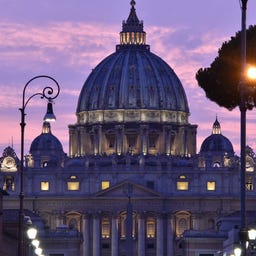
The Vatican is – in the heart of Rome – the smallest independent state in the world and is home to some of the world's most beautiful masterpieces. A visit is among the top highlights in all of Europe. Both St. Peter's Basilica with its monumental dome and the Sistine Chapel, featuring Michelangelo's breathtaking frescoes, attract millions of visitors each year.
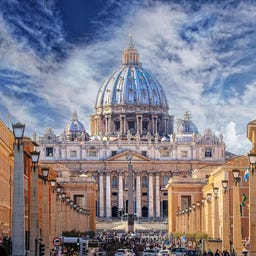
St. Peter's Basilica, the largest church in the world and the heart of the Vatican, impresses with its masterful Italian Renaissance art. The majestic dome, designed by Michelangelo, rises high above the city and offers spectacular views of Rome - a climb is therefore a must. Inside, the basilica impresses with its magnificent marble interior and artistic statues, including the moving Pietà. A highlight is the visit to the necropolis beneath St. Peter's Basilica, where the tomb of the Apostle Peter lies.
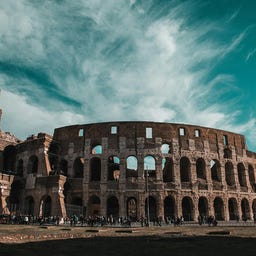
The Colosseum, an iconic symbol of ancient Rome's grandeur, stands as a remarkable testament to the architectural and engineering prowess of the Roman Empire. This colossal amphitheater, once the site of heart-stopping gladiator combats and ferocious battles with wild beasts, draws the gaze of over 7 million visitors each year.
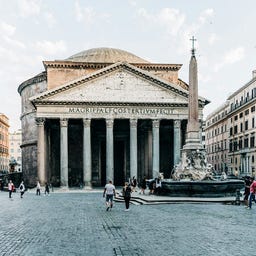
The 2000-year old Pantheon, a masterpiece of ancient architecture, stands as a monumental tribute to Roman engineering and artistry. This iconic structure was initially conceived as a temple to the 7 classical gods, and was later consecrated as a Christian Church. Walking through its doors, one is immediately struck by the vast, open space of the rotunda, topped by the largest unreinforced concrete dome in the world. At the dome's zenith is the oculus, a 9-meter-wide aperture that floods the interior with natural light, creating a connection between the earth and the heavens.
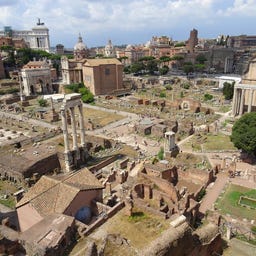
A visit to this impressive open-air museum is an absolute must for any visitor to Rome. Nestled between the Palatine and Capitoline Hills, it offers insight into the heyday of Roman civilization. Here, you can stroll through the remnants of majestic temples, basilicas, and triumphal arches that once formed the center of political and religious life.
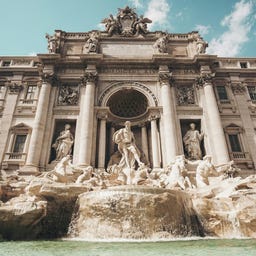
The Trevi Fountain, a masterful baroque marvel, is not just Rome's largest but also its most breathtaking fountain. Amid the hustle and bustle of the city, it stands as a grandiose display of mythical figures and cascading waters, captivating all who come to toss a coin and embrace its legend.
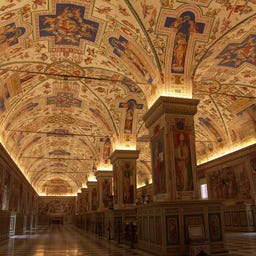
The Vatican Museums rank among the most spectacular and largest museum complexes in the world. Within its 26 museums and 7km (approximately 4.3 miles) of halls and galleries, an impressive collection of over 70,000 works is preserved, of which 20,000 are on display. From the Sistine Chapel, adorned with Michelangelo's breathtaking frescoes, to the intricately detailed Raphael Rooms and the aesthetically pleasing Spiral Staircase – the Museums offer a unique journey through the history of art and culture.
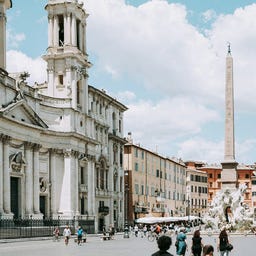
As the first rays of sun touch the cobblestones, Rome's most beloved and picturesque square awakens with its fountains casting soft shadows. By day, it transforms into a vibrant hub, buzzing with the energy of bustling cafés, street performers, and portrait artists. The original piazza was constructed atop the 30,000-seat stadium di Domiziano in 86 CE. One can still access the ruins for a ticket of €9.
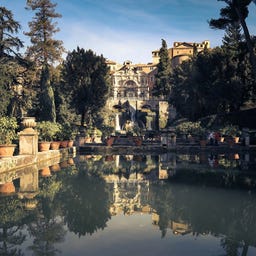
The Villa d'Este, built in the 16th century, is a Renaissance masterpiece of architecture and garden design. Commissioned by Cardinal Ippolito II d'Este and led by architect Pirro Ligorio, the villa is famous for its over 500 fountains, operated by an ingenious hydraulic system without modern pumps. The terraced gardens are particularly noteworthy, featuring cascades, water features, and artistic sculptures that beautifully blend nature and art.
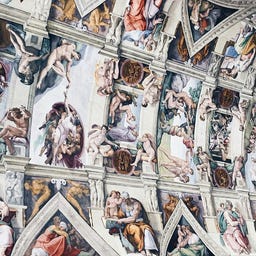
The Sistine Chapel is a pinnacle of Renaissance art and a must-visit for anyone stepping into the Vatican Museums. It's famed for Michelangelo's iconic ceiling frescoes and The Last Judgment. The sheer scale and artistic mastery of Michelangelo's work make it an unforgettable experience.
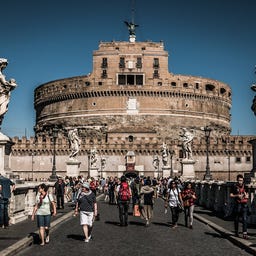
Castel Sant'Angelo, originally built as a mausoleum for Emperor Hadrian, is now a fascinating museum. It got its name from a vision of Pope Gregory I in 590 AD: the Archangel Michael appeared to him, sheathed his sword, and thus announced the end of the plague. Inside the castle, you can admire the magnificent Sala Paolina, with frescoes depicting episodes from the life of Alexander the Great.

The Abbey of Monte Cassino is very impressive and definitely worth a detour when traveling from Rome to Naples. Located on a mountain near Cassino, it features a magnificent cathedral, a small museum, and an elegant Renaissance cloister with stunning views —perfect for photos!
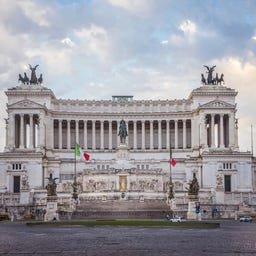
The monumental Victor Emmanuel II Monument in Rome, also known as the Vittoriano, is a magnificent example of Italian architecture. It was built between 1885 and 1925 to honor the first king of a united Italy. The structure dominates Piazza Venezia with its impressive size and white marble construction. The Altar of the Fatherland, located inside, is a significant memorial for the Unknown Soldier and attracts thousands of visitors annually. The panoramic view from the terrace over the historic center of Rome is outstanding.
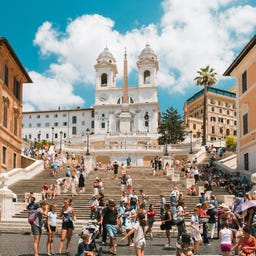
The Spanish Steps, a monumental staircase with 138 steps, connect Piazza di Spagna with the church of Trinità dei Monti. Built in 1725, it is an outstanding example of Baroque architecture and a popular meeting place for both locals and tourists. Especially in spring, when adorned with blooming azaleas, the staircase offers a stunning sight.
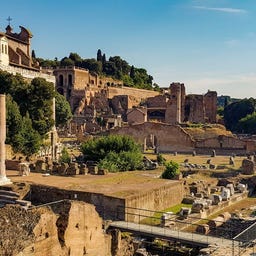
The Palatine Hill is the legendary site where the cave of Romulus and Remus, who were found by the she-wolf, was located, and it is one of Rome's most significant archaeological sites. As Rome developed, the hill became a coveted residential area for the elite, including Emperor Augustus, whose house is still one of the best-preserved sites there.
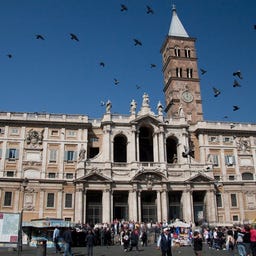
The Basilica of Santa Maria Maggiore is renowned for its stunning 5th-century mosaics depicting scenes from the Old Testament. As one of Rome’s four major papal basilicas, it impresses with its baroque facade (18th century) and opulent interiors.
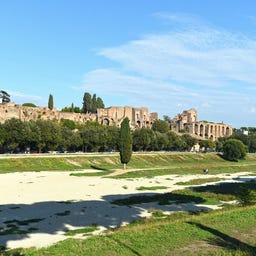
The Circus Maximus, once the largest arena of ancient Rome, was the site of spectacular chariot races and grand events. The remains of this gigantic stadium, which could accommodate up to 250,000 spectators, testify to its monumental size. On the steps that once held the audience, you have an impressive view of the surroundings and get a sense of Roman history. It is a perfect place to relax and take cool photos.
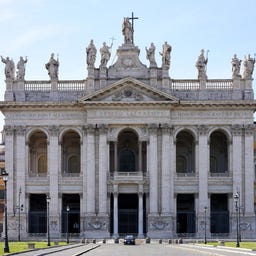
The Archbasilica of St. John Lateran, or just the Lateran Basilica, is the oldest and highest-ranking of the four major papal basilicas. Not only that, it was founded in 324 AD by Emperor Constantine the Great, making it the very first Christian basilica ever! Its remarkable history and artistic treasures make it a must-see for anyone interested in early Christian architecture and history.
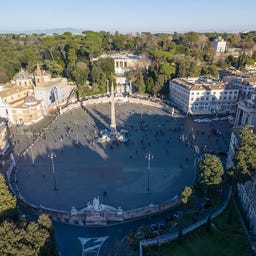
The Piazza is one of the largest squares in Rome (at the north gate of the city) and is known for its impressive Egyptian obelisk, the accompanying fountains, and the twin churches Santa Maria dei Miracoli and Santa Maria in Montesanto.
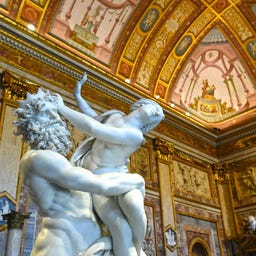
The Galleria Borghese is a true paradise for art lovers. The elegant Villa Borghese, surrounded by lush gardens, was built in 1607 by Cardinal Scipione Borghese. Today, it houses a world-famous art museum with an impressive collection of masterpieces.
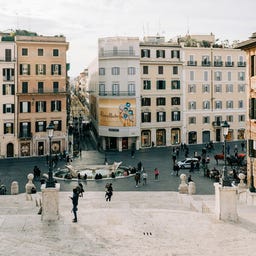
Located at the famous Spanish Steps with its 136 steps, Piazza di Spagna is one of the liveliest squares in Rome. The butterfly-shaped square gets its name from the Spanish Embassy Palace, which has represented the Holy See here since the 17th century.
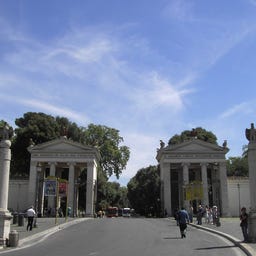
The Villa Borghese Gardens span about 80 hectares, offering not only attractions like the Galleria Borghese, a zoo, cinema (Casa del Cinema), and a replica of London's Globe Theatre, but above all, peace and relaxation from the hustle and bustle. If you need a break from the many sights and the noise of the city, come to the park with its small lake and the Temple of Aesculapius for a picnic or a boat ride. For children, there are playgrounds and the Bio Parco zoo.
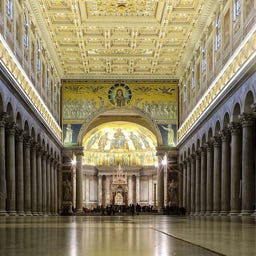
The Basilica of St. Paul Outside the Walls is one of Rome’s most significant pilgrimage sites, renowned for its immense size and spiritual importance. Located about 2 km south of the Aurelian Walls near the Tiber, this papal basilica was built over the tomb of the Apostle Paul.
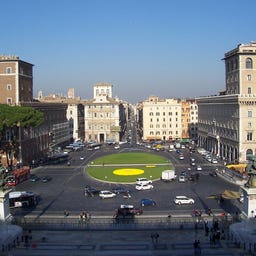
When visiting Rome, you’ll inevitably come across Piazza Venezia, one of the city’s most busy squares. Dominated by the grand Vittoriano, a white marble monument honoring Italy’s first king, this square pulses with the energy of Rome.
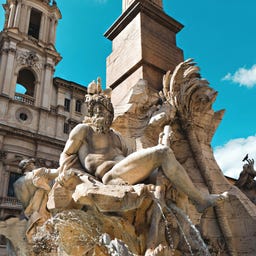
The Fontana dei Quattro Fiumi is a popular Roman landmark at the heart of Piazza Navona, one of the city's most renowned Baroque squares. Designed by Gian Lorenzo Bernini in the 17th century, it represents the four major rivers of the known world at the time: the Nile, Ganges, Rio de la Plata, and Danube.
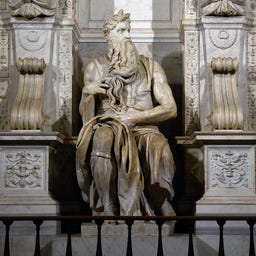
In the Roman Basilica of San Pietro in Vincoli, Michelangelo's famous marble sculpture of Moses stands tall - a 235 cm tall masterpiece at the center of Julius's tomb. You can immediately recognize the figure by its distinctive horns, which stem from a translation error of the Book of Exodus. Pay close attention to the intricately carved beard, so lifelike that it appears more painted than chiseled from stone. Some even claim to see hidden profiles of Pope Julius II and a woman in the beard.
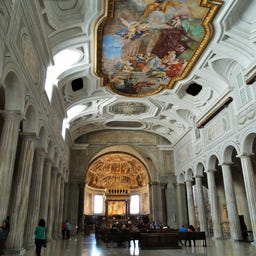
In the Basilica di San Pietro in Vincoli, you will find one of the most impressive Renaissance sculptures in Rome: Michelangelo's famous Moses, which adorns the tomb of Pope Julius II.
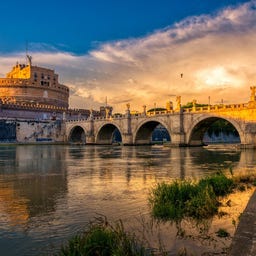
The Ponte Sant'Angelo, built in the 2nd century AD by Emperor Hadrian, leads directly to the imposing Castel Sant'Angelo, originally constructed as Hadrian's mausoleum. What makes the bridge truly special, though, are the 10 stunning Baroque angel statues, created by Gian Lorenzo Bernini and his pupils in the 17th century. Each statue holds a symbol of Christ's Passion—take a moment to admire the details.
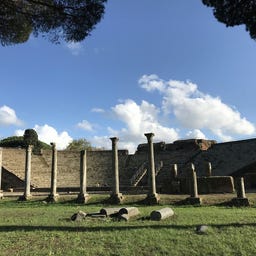
In the extensive ruins of Ostia Antica, the first Roman colony from the 7th century BC, you discover one of the best-preserved ancient cities in Italy.
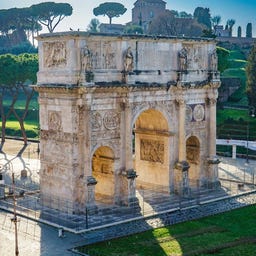
Right next to the Colosseum, the impressive Arch of Constantine rises, one of the best-preserved structures of its kind in ancient Rome. The 21-meter-high marble arch was built in 315 AD to celebrate Constantine's victory over Maxentius - a particular historical irony, as it immortalized a victory over fellow Romans.

The Trajan's Column is a nearly 40-meter-high masterpiece of Roman sculpture from the 2nd century, depicting Trajan's victory over the Dacians in a unique relief band. The story of the campaign winds around the column, made of massive Carrara marble blocks, in 24 spirals, featuring over 2500 detailed figures.
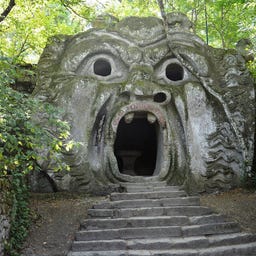
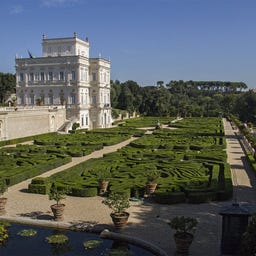
In the Villa Doria Pamphilj, the third largest public park in Rome, you will find an impressive blend of historic architecture and expansive green spaces spread over 184 hectares.
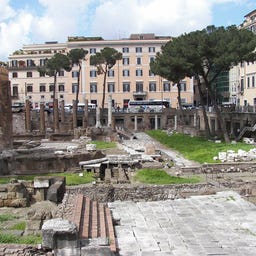
In the heart of Rome, you will find the fascinating archaeological complex of Largo di Torre Argentina, which houses the remains of four ancient temples from the time of the Roman Republic. It was at this historic site that Julius Caesar was assassinated in 44 BC, before the area was built over in the Middle Ages and later excavated again between 1926 and 1929.
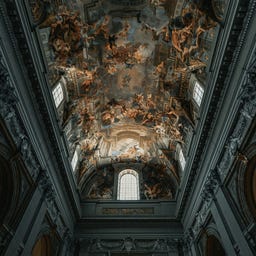
The Church of Sant'Ignazio di Loyola, a Baroque masterpiece built between 1626 and 1650, lies in the heart of Rome, often overshadowed by more famous landmarks like the Pantheon. Yet, it truly deserves a place on every itinerary.

Amidst the stunning grandeur of St. Peter's Basilica stands Michelangelo's Pietà, a world-renowned sculpture depicting the Virgin Mary cradling the dead Christ. This masterpiece is a poignant symbol of both grief and the profound bond between mother and son.
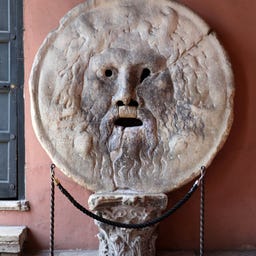
On the outer wall of the Roman Basilica Santa Maria in Cosmedin, you will find the famous Bocca della Verità - an ancient marble mask featuring the distinctive face of a bearded man.
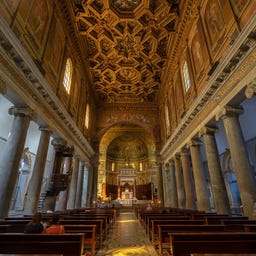
In the lively Trastevere district, the Basilica of Santa Maria in Trastevere stands as a must-visit, possibly the first officially Christian church in Rome. Its origins trace back to the 3rd century under Pope Callixtus I, with a major reconstruction by Pope Innocent II in the 12th century.

The Baths of Caracalla (212–216 AD) rank among the most impressive ancient thermal complexes, offering a captivating insight into the social and cultural life of 3rd-century Rome. At their peak, they accommodated over 1,600 daily visitors, who relaxed in a variety of baths, from the hot Caldarium to the cool Frigidarium.
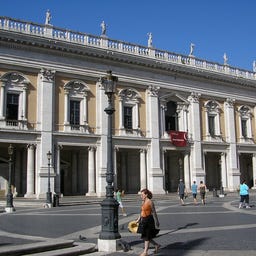
The Capitoline Museums are not only the world’s oldest public museums, but also a testament to Rome’s complex and often contradictory history. Founded in 1471 by Pope Sixtus IV on the Capitoline Hill, the museums house a captivating mix of ancient treasures, Renaissance masterpieces, and lesser-known yet equally remarkable artifacts.
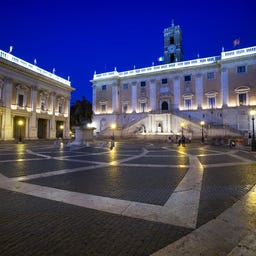
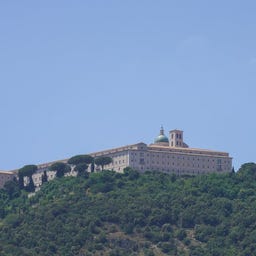
High above the Italian landscape stands the Abbey of Montecassino, founded in 529 by Benedict of Nursia as the first home of the Benedictine order. After being destroyed multiple times - including by Lombards and Saracens - the monastery experienced its golden age in the 11th and 12th centuries, becoming the most powerful monastery in the Catholic world.
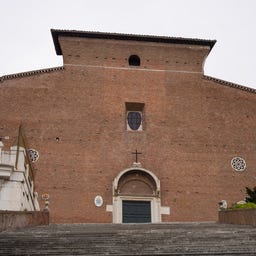
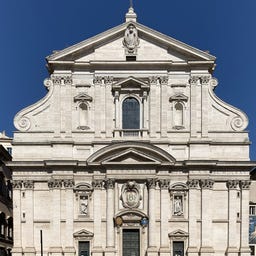
The Chiesa del Gesù is considered the mother church of the Jesuit order and was built between 1568 and 1580 according to the vision of the order's founder, Ignatius of Loyola. The single-nave church, with its impressive dome designed by Giacomo Della Porta, set new standards and served as a model for Jesuit churches around the world.
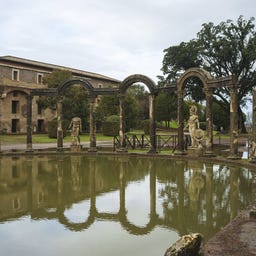
Just 28 km east of Rome, you will find the Villa Adriana, one of Italy's most impressive archaeological sites, covering 120 hectares. Built between 121 and 137 AD, this imperial residence of the Roman Emperor Hadrian combines architectural elements from all parts of the Roman Empire. In the expansive complex, you can explore magnificent remains of various building complexes, such as the Pecile, a replica of the colonnade from Athens, and the Canopus with its colonnaded water basin. After its rediscovery during the Renaissance, this UNESCO World Heritage site became a source of inspiration for numerous artists and architects.
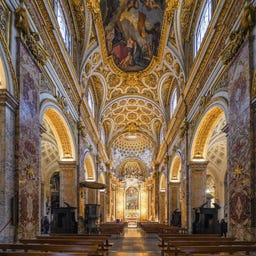
Near Piazza Navona, you will find the magnificent Chiesa di San Luigi dei Francesi, the national church of the French in Rome, which was completed in the late 16th century. Behind its Renaissance façade adorned with statues of saints lies an impressive church interior in the styles of Renaissance and Baroque, which was extensively renovated between 1749 and 1764. In the famous Contarelli Chapel, you can see three masterpieces by Caravaggio, including "The Calling of Saint Matthew." The church, dedicated to Saint Louis IX of France, also features significant frescoes depicting French history and continues to serve as a spiritual center for the French community in Rome.
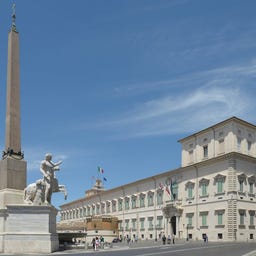
The Palazzo del Quirinale, the official residence of the Italian President since 1946, majestically sits on the Quirinal Hill and is one of the largest palaces in the world, covering 110,500 m². This magnificent building, started in the 16th century by Ottaviano Mascherino, was initially a papal summer residence, later became a royal palace, and today houses an impressive collection of artworks in its 1,200 rooms, including 260 historical tapestries.
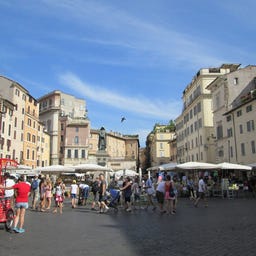
Campo de' Fiori is one of Rome's most vibrant and historically significant squares. Every day, it transforms into a bustling market, offering fresh fruits, vegetables, and souvenirs – the perfect way to experience local life.
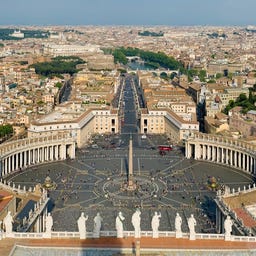
St. Peter's Square, built between 1656 and 1667, stretches out in front of St. Peter's Basilica and forms a monumental oval area 240m wide and 196m deep. The colonnade, designed by Gian Lorenzo Bernini, with its 284 Doric columns, majestically frames the square and symbolizes the "embracing arms" of the Church. At the center stands a 25m high Egyptian obelisk, once part of Nero's Circus (13th century BC). It is flanked by two impressive fountains, created by Carlo Maderno and Gian Lorenzo Bernini. The square is not only an architectural marvel but also a spiritual center, where millions of believers from around the world gather to receive the Pope's blessing.

In the magnificent basilica, which was integrated into the remains of the ancient Diocletian Baths in the 16th century, Roman bathing culture and Christian sacred architecture come together to create a unique masterpiece. Michelangelo's last major design was later refined by Luigi Vanvitelli in the 18th century with magnificent decorations and now houses significant artworks like Domenichino's "Martyrdom of Saint Sebastian."
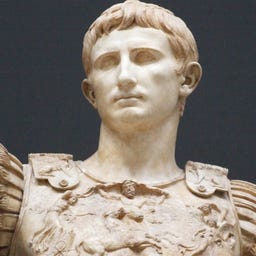
The impressive marble statue of Augustus of Prima Porta is one of the most significant representations of emperors from ancient Rome and was discovered in 1863 in the villa of his wife Livia. Standing barefoot at 2.04 meters tall, the emperor is depicted in full military armor with an elaborately decorated breastplate, symbolizing his divine lineage.
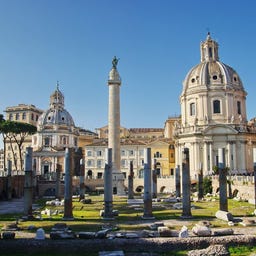
The largest and most magnificent of the Roman imperial forums was inaugurated in 112 AD by Emperor Trajan, who financed it with war booty from his Dacian campaigns. The complex, designed by Apollodorus of Damascus, covers an area of 300 by 185 meters and houses the monumental Basilica Ulpia, expansive colonnades, and the famous Trajan's Column.
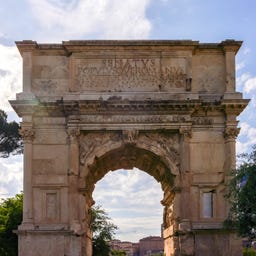
At the eastern edge of the Roman Forum, you can find the Arch of Titus, a single-arched triumphal arch dedicated to the Roman Emperor Titus and his conquest of Jerusalem in 70 AD. This marble arch, erected by the Senate after Titus' death, impresses with its intricate reliefs depicting the triumphant entry into Rome and the spoils taken from the Temple in Jerusalem.
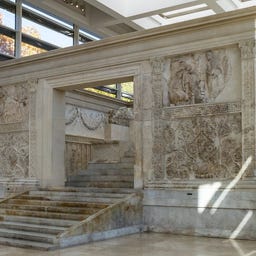
The Ara Pacis - the monumental "Altar of Peace" - is one of the most significant surviving monuments of ancient Rome and was inaugurated by Emperor Augustus in 9 BC. The nearly square marble structure impresses with its intricate relief friezes and elaborate acanthus vines that adorn both the exterior and interior walls.
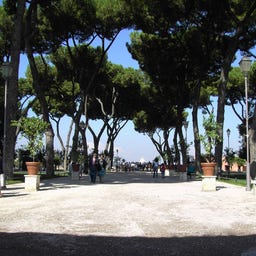
On the Aventine Hill, you will find the Giardino degli Aranci, an atmospheric park known for its bitter orange trees and one of the most beautiful panoramic views of Rome.
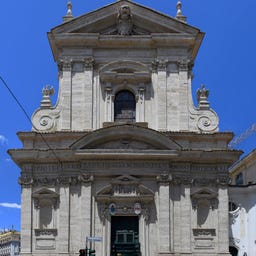
In the small Baroque church Chiesa di Santa Maria della Vittoria, you will find one of the most famous masterpieces of Roman Baroque: the spectacular sculpture group "Ecstasy of Saint Teresa" by Gian Lorenzo Bernini in the left transept. The building, designed by Carlo Maderno in the early 17th century, impresses with its single-nave interior adorned with magnificent ceiling frescoes by Gian Domenico Cerrini.
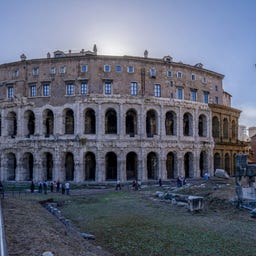
The Teatro di Marcello, planned by Julius Caesar and completed under Augustus, is one of the best-preserved theater buildings from ancient Rome. With its impressive facade featuring three rows of arches and a capacity of up to 20,000 spectators, it served as a model for many later Roman theaters starting from 17 BC.
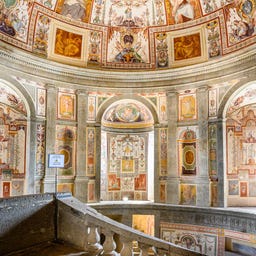
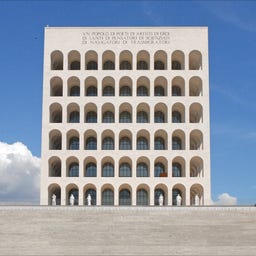
The monumental Palazzo della Civiltà Italiana, also known by locals as the "Colosseo quadrato" or "Palazzo groviera," has been a defining feature of the EUR district in Rome since 1940. With its 54 arches on each of the four identical facades and its entirely travertine-clad concrete structure, it embodies the distinctive architecture of the late 1930s.
In the futuristic Auditorium Parco della Musica, designed by star architect Renzo Piano, you will find one of the most significant cultural complexes in Europe, featuring three distinctive concert halls shaped like scarabs. Opened in 2002 and named after the composer Ennio Morricone since 2020, the facility also includes an impressive open-air theater for 3,000 spectators and a small museum showcasing Roman archaeological finds.
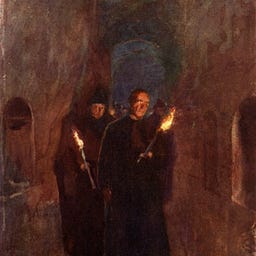
The Catacombs of Rome offer a captivating journey into the underworld of the Eternal City. These underground cemeteries, used by Christians and Jews between the 2nd and 5th centuries, provide a unique glimpse into early Christian art. Created due to above-ground space shortages, they reveal stories of life and death during a time of religious persecution and change.
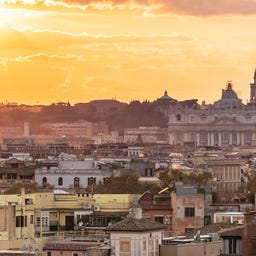
The hill Il Pincio, in northeast Rome, offers a spectacular view of the city. Originally outside the ancient city limits, it was later incorporated within the Aurelian Walls. The garden is renowned not only for its views and street musicians but also for its garden art, including the Horti Luculliani and Horti Sallustiani.

Just a few steps from the Colosseum, the Basilica of San Clemente offers you a fascinating journey through three eras of Roman history. While the current church from the 12th century impresses with its magnificent mosaics and Cosmatesque floor, descending into the lower levels takes you to an early Christian basilica and even deeper to Roman buildings from the time after Nero.
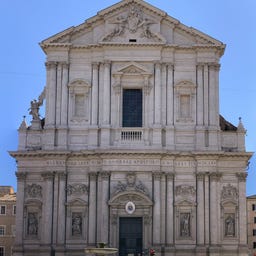
With its impressive Baroque facade and the second-largest dome in Rome, Sant'Andrea della Valle has shaped the cityscape in the heart of the Sant'Eustachio district since the 17th century. The basilica, built between 1590 and 1650, owes its magnificent appearance to the master architects Carlo Maderno and Carlo Rainaldi, who set lasting standards with the 71-meter-high dome and the striking travertine facade. Inside, you can expect to see stunning frescoes by Giovanni Lanfranco and Domenichino, as well as a spacious nave with eight side chapels. Opera fans will recognize the church as the setting for the first act of Puccini's "Tosca."
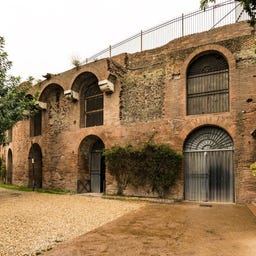
Dive into the fascinating history of the Domus Aurea, the "Golden House," which Emperor Nero had built as a massive palace complex after the great fire of Rome in 64 AD. This magnificent structure, covering 80 hectares with its expansive gardens, banquet halls, and an artificial lake, was partially destroyed after Nero's death and buried under later constructions like the Trajan Baths.
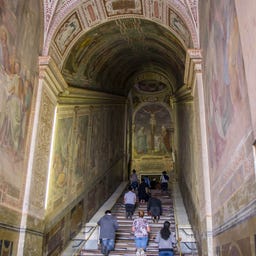
The 28 white marble steps of the Scala Santa in Rome are said to be the ones that Jesus ascended before his crucifixion in the palace of Pontius Pilate. The holy staircase was brought to Rome in 326 AD by Helena, the mother of Emperor Constantine I, and was moved to its current location near the Basilica San Giovanni in Laterano in 1589.
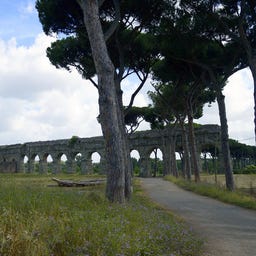
In the Parco degli Acquedotti, a 240-hectare historical park in the southeast of Rome, you encounter the ancient history of the city at every turn. Seven Roman and papal aqueducts traverse the expansive park landscape, including the impressive remains of the Acquedotto Claudio and Anio Novus.

Majestically, the Basilica di Santa Maria in Aracoeli sits atop the Capitoline Hill, which you can reach via a monumental staircase with 124 steps built in the 14th century. This church, established in the 6th century, combines Roman-Gothic architecture with Baroque elements and impresses with its wooden coffered ceiling from the 16th century and the intricate Cosmatesque floor from the 13th century.
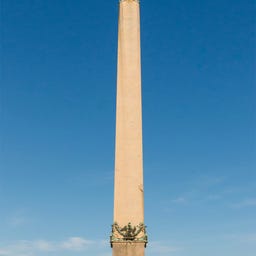
Majestically, the 40-meter-high Vatican Obelisk rises in the center of St. Peter's Square - as the only one of the thirteen ancient obelisks in Rome, it has never toppled over. This colossal structure, made of red granite, was brought from Egypt to Rome by Caligula in 40 AD and originally stood in the Circus of Nero.
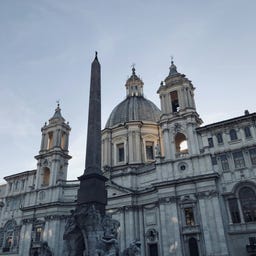
At Piazza Navona, you will find the baroque Chiesa di Sant'Agnese in Agone, built between 1652 and 1672 on the site where, according to legend, Saint Agnes suffered her martyrdom. The striking church, initially designed by Girolamo Rainaldi and later transformed by Francesco Borromini, captivates with its concave façade featuring two bell towers and an impressive dome.
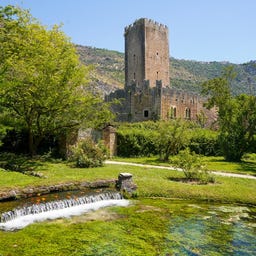
In the picturesque ruins of the medieval town of Ninfa, one of Italy's most fascinating gardens stretches over 106 hectares, which the New York Times has called the "most beautiful garden in the world."
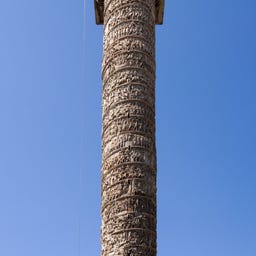
The monumental column of the Roman Emperor Marcus Aurelius has stood in the heart of Rome at Piazza Colonna since the late 2nd century. With a total height of 42 meters and a relief band that spirals 21 times around the column, it depicts 116 scenes of the emperor's victories over Germanic and Sarmatian tribes. This structure, made of 27 blocks of marble, was built between 180 and 193 AD by Commodus in honor of his father and contains a spiral staircase with 203 steps inside. While the original bronze statue of the emperor was lost in the Middle Ages, the column itself survived even the severe earthquakes of the 9th century and was restored in 1589 by Pope Sixtus V.
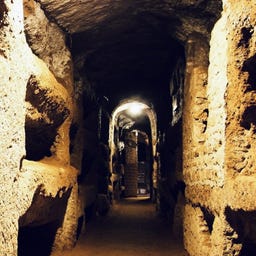
In the expansive catacombs of San Callisto, named after the deacon Callistus I, underground passages stretch impressively for almost 20 kilometers. Established at the end of the 2nd century, this burial site became the official cemetery of the Catholic Church and is home to the graves of 16 popes as well as significant saints.
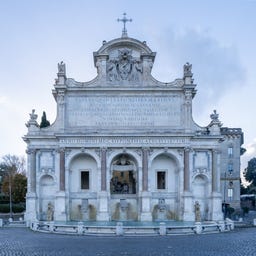
Majestically, the Fontana dell'Acqua Paola - affectionately called "Fontanone del Gianicolo" by the Romans - stands on the Gianicolo Hill, impressing with its grand facade of five arches and ancient granite columns. This monumental fountain was commissioned by Pope Paul V in the early 17th century and designed by architects Giovanni Fontana and Flaminio Ponzio to celebrate the restoration of the Roman aqueduct.
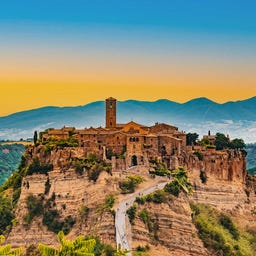
The Dying City majestically perches on a slowly eroding volcanic rock, accessible only via a narrow, dizzying 366-meter long pedestrian bridge. A day trip to Civita di Bagnoregio feels like a journey back in time.
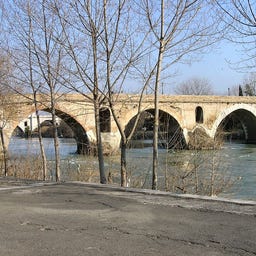
The Ponte Milvio is one of the oldest and most historically significant bridges in Rome, with its first mention dating back to 207 BC. In 312 AD, this stone arch bridge was the site of the famous battle between Constantine I and Maxentius, which not only determined the fate of the Roman Empire but also the future of Christianity in Europe.
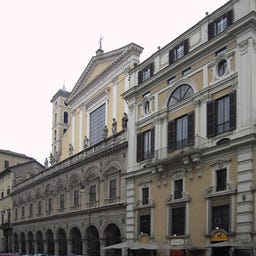
In the largest noble palace of Rome, you can expect a fascinating insight into the history of one of the city's most significant noble families. The Palazzo Colonna, which dates back to the 12th century, was the only palace to survive the sacking of Rome in 1527, thanks to the presence of Isabella d'Este.
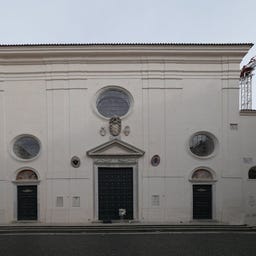
Just a few steps from the Pantheon, you will find the Basilica di Santa Maria sopra Minerva, one of the rare Gothic churches in Rome. Construction began in the 13th century and it houses the mortal remains of Saint Catherine of Siena as well as significant artworks, including impressive frescoes by Filippino Lippi.
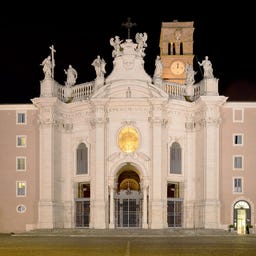
In the Basilica di Santa Croce in Gerusalemme, you will find one of the most significant collections of relics in Rome, including pieces of the "True Cross" and the crown of thorns of Jesus. The church, built in the 4th century by Helena, the mother of Emperor Constantine, is part of the "Seven Churches of Rome" and was constructed on the remains of an imperial villa.
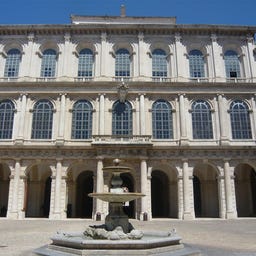
In the magnificent Palazzo Barberini from the 17th century, just a few steps away from Piazza Barberini, you will find one of Rome's most significant art treasures: the Galleria Nazionale d'Arte Antica.
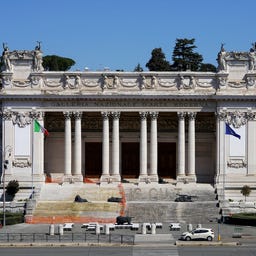
In the Galleria Nazionale d'Arte Moderna e Contemporanea, you will find Italy's most significant collection of art from the 19th century to the present, featuring nearly 20,000 works. The impressive museum building, designed by architect Cesare Bazzani, has housed masterpieces from Antonio Canova to Pablo Picasso since 1911 and showcases all major art movements from Neoclassicism to Surrealism.
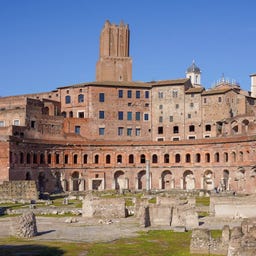
The Mercati di Traiano, an impressive complex from the early 2nd century, spans six levels and forms a distinctive semicircular shape in the historic center of Rome. Contrary to its modern name, the site served less as a market and more as an administrative center for the Imperial Forums.
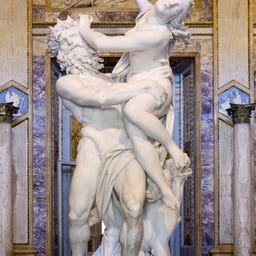
In the Galleria Borghese, you can admire one of the most impressive masterpieces of the Baroque period, the "Rape of Proserpina." This 255 cm tall sculpture made of white Carrara marble was created by Gian Lorenzo Bernini between 1621 and 1622, capturing the dramatic moment when Pluto abducts the resisting Proserpina.
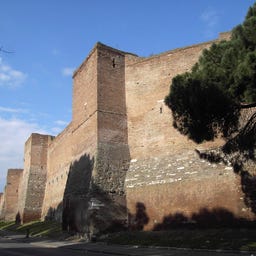
The Aurelian Walls, Rome's ancient city walls from the 3rd century, are among the longest and best-preserved ancient fortifications in the world, originally stretching 19 kilometers. Built by Emperor Aurelian between 270 and 275 AD to protect against barbarian invasions, the walls now extend 12.5 kilometers and enclose an area of over 1,200 hectares. The structure, featuring towers and battlements, includes 18 historical main gates and cleverly incorporates existing buildings like the Pyramid of Cestius. At the Museo delle Mura in the Porta San Sebastiano, you can explore the history of this impressive defensive structure, which maintained its military significance until Rome's capture in 1870.
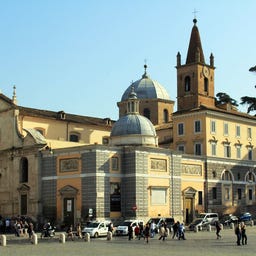
The Renaissance basilica at the northern end of Piazza del Popolo was founded in the 11th century to ward off Nero's evil spirit, believed to haunt his tomb there. Extensively renovated under Pope Sixtus IV in the 15th century, it now showcases works by Caravaggio, Raphael, and Bernini.
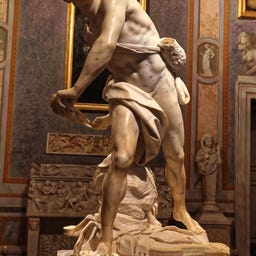
In the Galleria Borghese in Rome, you can see one of the most dynamic marble sculptures of the 17th century: the "David" by Gian Lorenzo Bernini. The 170 cm tall statue captures the biblical hero in a tense moment just before he throws the stone at Goliath, with David's face considered a self-portrait of the artist.
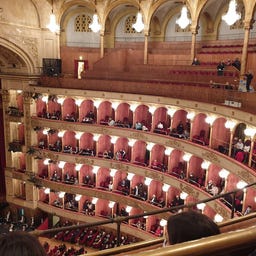
In the magnificent Teatro dell'Opera di Roma, built in 1880 by Domenico Costanzi and originally named after him, you will find one of Italy's most significant opera houses. The building, designed in the Neo-Renaissance style, impresses with its dome painted by Annibale Brugnoli and the largest crystal chandelier in Europe—a three-ton masterpiece made of 27,000 Bohemian crystals.
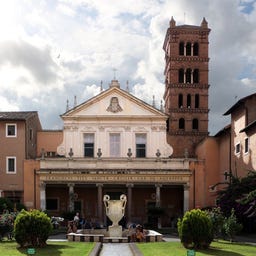
In the Basilica di Santa Cecilia in the lively Trastevere district of Rome, you encounter a fascinating journey through Christian history: The church is built on the foundations of a Roman townhouse from the 2nd century BC, where, according to tradition, Saint Cecilia met her martyrdom around 220 AD.
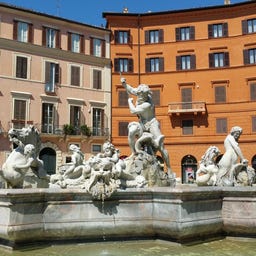
On the north side of Piazza Navona, you will find the impressive Fontana del Nettuno, which was originally known as the "Fontana dei Calderai." This fountain was commissioned in 1574 by Pope Gregory XIII and took on its current appearance with the dramatic sculpture group from 1878, depicting Neptune battling an octopus.
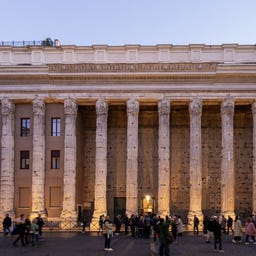
In the heart of Rome's historic center stands the impressive Temple of Hadrian, a temple completed around 145 AD by Emperor Antoninus Pius in honor of his deified predecessor Hadrian. Today, eleven 15-meter-high Corinthian columns made of white marble still testify to the original splendor of the structure, which have been integrated into the facade of the later Palazzo della Dogana.
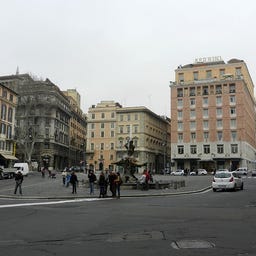
On the Piazza Barberini in the historic center of Rome, you will find one of the most impressive Baroque fountains in the city - the Fontana del Tritone, created by Gian Lorenzo Bernini in 1643 from travertine.

The Apostolic Palace, also known as the Vatican Palace, is the official residence of the Pope in Vatican City. It houses over 1,000 rooms, including living and working spaces for the Roman Curia, the splendid Papal Apartments, the world-famous Vatican Library, and numerous chapels. Parts of it are now open to the public. The older sections of the palace are integrated into the Vatican Museums, including the Sistine Chapel, the Cappella Niccolina, the Raphael Rooms, and the Borgia Apartments.
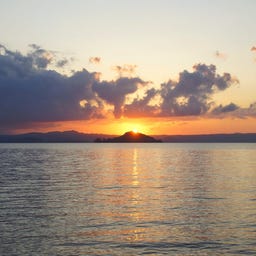
As the largest volcanic lake in Europe, Lago di Bolsena offers you an impressive backdrop with its two islands, Isola Bisentina and Isola Martana, for relaxing swimming and nature experiences. The lake, formed over 300,000 years ago by the collapse of volcanic craters, is known for its crystal-clear water and is one of the few large Italian lakes where you can swim anywhere.
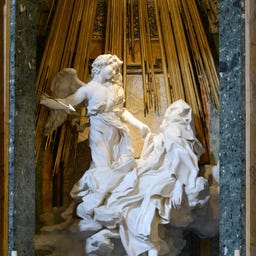
In the Church of Santa Maria della Vittoria, you will encounter one of the most impressive masterpieces of Roman Baroque art: the "Ecstasy of Saint Teresa." Created by Gian Lorenzo Bernini between 1647 and 1652, this marble sculpture captures the mystical moment when an angel pierces the heart of the saint with a fiery arrow.
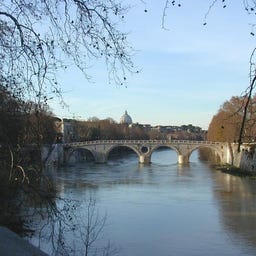
The elegant Ponte Sisto connects the Piazza S. Vincenzo Pallotti with the Piazza Trilussa as a pedestrian bridge over the Tiber and was built between 1473 and 1479 by Pope Sixtus IV. With its four distinctive arches and the notable round hole in the middle pillar, known as the "Oculo," it was cleverly designed to reduce water pressure during floods. The current bridge stands on the site of an ancient predecessor built by Agrippa in the 1st century BC and was originally intended to safely guide the flow of pilgrims across the river during the Holy Year of 1475.
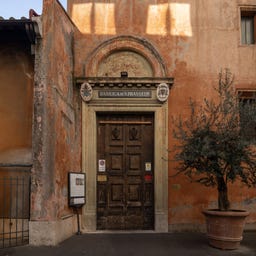
The Basilica di Santa Prassede is one of the most fascinating church buildings in Rome from the 9th century, when Pope Paschal I. had it rebuilt on the foundations of an early Christian predecessor. Just a few steps away from the mighty Santa Maria Maggiore, it houses some of the most significant mosaics from this era in the city.
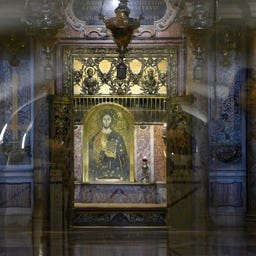
Deep beneath the main altar of St. Peter's Basilica lies the tomb of the Apostle Peter in the Vatican Grottoes - one of the most significant pilgrimage sites for Christians. The original burial site on Vatican Hill was covered by the first St. Peter's Basilica in the 4th century by Emperor Constantine, after the relics had to be temporarily hidden in the Catacombs of San Sebastiano during the persecutions of Christians.
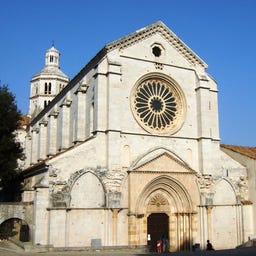
In the Abbazia di Fossanova, the oldest example of Cistercian art in Italy, you experience the fascinating transition from Romanesque to Gothic architecture. The monastery complex, built between 1163 and 1208, impresses with its simple yet majestic facade featuring a large rose window and was personally consecrated by Pope Innocent III.
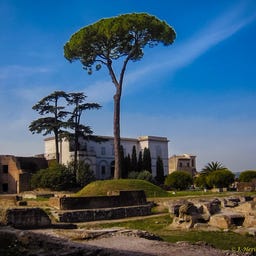
On the historic Palatine in Rome, you will find the Antiquarium del Palatino, a fascinating museum that preserves the artistic treasures of the imperial era. Founded by Pietro Rosa in the 19th century, the museum showcases the development of the hill from its origins to the late imperial period across two floors.
